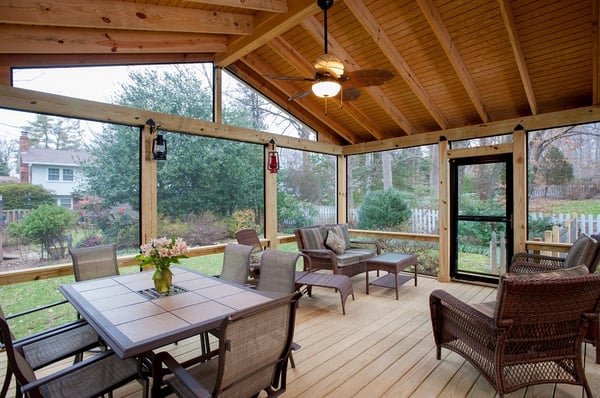Though composite decking takes over the deck and porch markets, pressure-treated wood is still a popular option. It differentiates itself from its untreated sibling with a special process that gives it a hardier character. One that is more resistant to moisture, the elements, and general physical damage. It is most commonly used to build playgrounds, boardwalks, poles, and decks. Design Builders has the details on pressure treated wood in todays blog.
During the treatement process, pressure and vacuum technology are used to force protective chemical preservatives into standard woods like spruce, fur, or pine. This renders it a sturdier building material that is less susceptible to rot, fungal decay, and insects. However, it is not ideal for every homeowner's personal construction project.
Advantages of Pressure-Treated Wood Decks
Affordability. Pressure-treated wood is notably cheaper than cedar, redwood, and other types of wood. And, because of its durability, you’re much less likely to experience a need for costly repairs in the future. It is a great choice for those operating on a smaller budget.
Versatility. Pressure-treated wood is a blank canvas, being easy to work with and able to be stained or painted any color you desire. This makes it a wonderful option if you are trying to match the color of an existing feature of your house, such as an interior hardwood. Be sure to paint or stain only when the wood is completely dry.
Durability. Pressure-treated wood is more durable than many other types of wood, better-able to resist dents, scratches, and wear. Pressure-treated wood’s extra strength gives it a long lifespan, ensuring that it will last for decades to come with proper care.
Ease of repair. In the event of a grilling accident or curiously destructive child, pressure-treated wood is easily and inexpensively repaired.
Insect repellency. The chemicals used in treating this type of wood repel bugs and insects, keeping them away from your home and reducing incidents of insect damage. This will save you money over time that would otherwise be spent on insect-proofing solutions.
Natural. This type of building material is made from natural wood. The most commonly treated wood is pine, an environmentally-friendly choice because of its fast growth.

Disadvantages of Pressure-Treated Wood Decks
Splinters and checking. Since this type of decking material is made from natural wood, it will inevitably splinter with time. After being outdoors for six to twelve months, treated decks may also experience checking, a process where wood begins to dry out and split apart due to exposure to alternate cycles of wetting and drying.
Fading. Color fading will most likely occur as the wood is exposed to ultraviolet rays from the sun over time.
High-maintenance. To protect your deck from these disadvantages - splintering, checking, fading, or becoming porous and soft - you must stain and apply a penetrating sealer to the wood annually. Without proper care, the wood will retain stains and blemishes from leaves and debris.
Chemical risks. Because this type of decking is treated with chemicals for protection, it can be hazardous when not handled correctly. If the wood is burned, trimmed, or cut, it can release harmful toxins into the air. Pressure-treated wood should not be used for gardens or come in frequent contact with food and water.
When working with this type of wood, it’s important to remain in a well-ventilated area and wear masks, safety goggles, and gloves. Be sure to wash your hands and clothes thoroughly after working with pressure-treated wood. If you are disposing of this type of wood, you should treat it as a potentially hazardous material and bring it to a recycling center that handles this type of product, or hire a professional who knows how to properly dispose of it.



